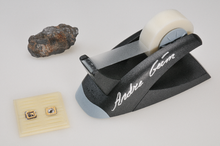Single-layer graphene was first unambiguously produced and identified in 2004, by the group of Andre Geim and Konstantin Novoselov, though they credit Hanns-Peter Boehm and his co-workers for the experimental discovery of graphene in 1962; while it had been explored theoretically by P. R. Wallace in 1947. [1][2] Boehm et al. introduced the term graphene in 1986.[3][4]


Early history
editIn 1859, Benjamin Collins Brodie became aware of the highly lamellar structure of thermally reduced graphite oxide.[5][6]
The structure of graphite was identified in 1916[7] by the related method of powder diffraction.[8] It was studied in detail by Kohlschütter and Haenni in 1918, who described the properties of graphite oxide paper.[9] Its structure was determined from single-crystal diffraction in 1924.[10]
The theory of graphene was first explored by P. R. Wallace in 1947 as a starting point for understanding the electronic properties of 3D graphite.[3][11] The emergent massless Dirac equation was first pointed out by Gordon W. Semenoff, David DiVincenzo and Eugene J. Mele.[12] Semenoff emphasized the occurrence in a magnetic field of an electronic Landau level precisely at the Dirac point. This level is responsible for the anomalous integer quantum Hall effect.[13][14][15]
The earliest TEM images of few-layer graphite were published by G. Ruess and F. Vogt in 1948.[16] Later, single graphene layers were observed directly by electron microscopy.[17] Before 2004 intercalated graphite compounds were studied under a transmission electron microscope (TEM). Researchers occasionally observed thin graphitic flakes ("few-layer graphene") and possibly even individual layers. An early, detailed study on few-layer graphite dates to 1962 when Boehm reported producing monolayer flakes of reduced graphene oxide.[18][19][20][21]
Starting in the 1970s single layers of graphite were grown epitaxially on top of other materials.[22] This "epitaxial graphene" consists of a single-atom-thick hexagonal lattice of sp2-bonded carbon atoms, as in free-standing graphene. However, significant charge transfers from the substrate to the epitaxial graphene, and in some cases, the d-orbitals of the substrate atoms hybridize with the π orbitals of graphene, which significantly alters the electronic structure of epitaxial graphene.
Single layers of graphite were observed by TEM within bulk materials, in particular inside soot obtained by chemical exfoliation. Efforts to make thin films of graphite by mechanical exfoliation started in 1990,[23] but nothing thinner than 50 to 100 layers was produced before 2004.
Naming
editThe term graphene was introduced in 1986 by chemists Hanns-Peter Boehm, Ralph Setton and Eberhard Stumpp. It is a combination of the word graphite and the suffix -ene, referring to polycyclic aromatic hydrocarbons.[3][4]
Discovery
editInitial attempts to make atomically thin graphitic films employed exfoliation techniques similar to the drawing method. Multilayer samples down to 10 nm in thickness were obtained. Earlier researchers tried to isolate graphene starting with intercalated compounds, producing very thin graphitic fragments (possibly monolayers).[20] Neither of the earlier observations was sufficient to launch the "graphene gold rush" that awaited macroscopic samples of extracted atomic planes.
One of the first patents pertaining to the production of graphene was filed in October 2002 and granted in 2006.[24] It detailed one of the first large scale graphene production processes. Two years later, in 2004 Geim and Novoselov extracted single-atom-thick crystallites from bulk graphite.[25] They pulled graphene layers from graphite and transferred them onto thin silicon dioxide (SiO
2) on a silicon wafer in a process called either micromechanical cleavage or the Scotch tape technique.[26] The SiO
2 electrically isolated the graphene and weakly interacted with it, providing nearly charge-neutral graphene layers. The silicon beneath the SiO
2 could be used as a "back gate" electrode to vary the charge density in the graphene over a wide range. US patent 6667100, filed in 2002, describes how to process expanded graphite to achieve a graphite thickness of one hundred-thousandth of an inch (0.25 nm). The key to success was high-throughput visual recognition of graphene on a properly chosen substrate that provides a small but noticeable optical contrast.
The cleavage technique led directly to the first observation of the anomalous quantum Hall effect in graphene,[13][15] which provided direct evidence of graphene's theoretically predicted Berry's phase of massless Dirac fermions. The effect was reported by Geim's group and by Kim and Zhang, whose papers[13][15] appeared in Nature in 2005. Before these experiments other researchers had looked for the quantum Hall effect[27] and Dirac fermions[28] in bulk graphite.
Geim and Novoselov received awards for their pioneering research on graphene, notably the 2010 Nobel Prize in Physics.[29]
Commercialization
editIn 2014, the National Graphene Institute was announced to support applied research and development in partnership with other research organizations and industry.[30]
Commercialization of graphene proceeded rapidly once commercial scale production was demonstrated. In 2014 two North East England commercial manufacturers, Applied Graphene Materials[31] and Thomas Swan Limited[32] (with Trinity College, Dublin researchers),[33] began manufacturing. In East Anglia Cambridge Nanosystems[34][35][36] operates a graphene powder production facility. By 2017, 13 years after creation of the first laboratory graphene electronic device, an integrated graphene electronics chip was produced commercially and marketed to pharmaceutical researchers by Nanomedical Diagnostics in San Diego.[37]
References
edit- ^ a b Geim, A K (2012). "Graphene prehistory". Physica Scripta. 146: 014003. Bibcode:2012PhST..146a4003G. doi:10.1088/0031-8949/2012/T146/014003.
- ^ Boehm, H. P.; Clauss, A.; Fischer, G. O.; Hofmann, U. (1 July 1962). "Das Adsorptionsverhalten sehr dünner Kohlenstoff-Folien". Zeitschrift für Anorganische und Allgemeine Chemie. 316 (3–4): 119–127. doi:10.1002/zaac.19623160303. ISSN 1521-3749.}
- ^ a b c Graphene. Encyclopaedia Britannica
- ^ a b Boehm, H.P; Setton, R; Stumpp, E (1986). "Nomenclature and terminology of graphite intercalation compounds". Carbon. 24 (2): 241. doi:10.1016/0008-6223(86)90126-0.
- ^ Geim, A. K. (2012). "Graphene Prehistory". Physica Scripta. T146: 014003. Bibcode:2012PhST..146a4003G. doi:10.1088/0031-8949/2012/T146/014003.
- ^ Brodie, B. C. (1859). "On the Atomic Weight of Graphite". Philosophical Transactions of the Royal Society of London. 149: 249–259. Bibcode:1859RSPT..149..249B. doi:10.1098/rstl.1859.0013. JSTOR 108699.
- ^ Debije, P; Scherrer, P (1916). "Interferenz an regellos orientierten Teilchen im Röntgenlicht I". Physikalische Zeitschrift (in German). 17: 277.
- ^ Friedrich, W (1913). "Eine neue Interferenzerscheinung bei Röntgenstrahlen". Physikalische Zeitschrift (in German). 14: 317.
Hull, AW (1917). "A New Method of X-ray Crystal Analysis". Phys. Rev. 10 (6): 661–696. Bibcode:1917PhRv...10..661H. doi:10.1103/PhysRev.10.661. - ^ Kohlschütter, V.; Haenni, P. (1919). "Zur Kenntnis des Graphitischen Kohlenstoffs und der Graphitsäure". Zeitschrift für anorganische und allgemeine Chemie (in German). 105 (1): 121–144. doi:10.1002/zaac.19191050109.
- ^ Bernal, JD (1924). "The Structure of Graphite". Proc. R. Soc. Lond. A106 (740): 749–773. Bibcode:1924RSPSA.106..749B. doi:10.1098/rspa.1924.0101. JSTOR 94336.
Hassel, O; Mack, H (1924). "Über die Kristallstruktur des Graphits". Zeitschrift für Physik (in German). 25 (1): 317–337. Bibcode:1924ZPhy...25..317H. doi:10.1007/BF01327534. S2CID 121157442. - ^ Wallace, P. R. (1947). "The Band Theory of Graphite". Physical Review. 71 (9): 622–634. Bibcode:1947PhRv...71..622W. doi:10.1103/PhysRev.71.622.
- ^ DiVincenzo, D. P.; Mele, E. J. (1984). "Self-Consistent Effective Mass Theory for Intralayer Screening in Graphite Intercalation Compounds". Physical Review B. 295 (4): 1685–1694. Bibcode:1984PhRvB..29.1685D. doi:10.1103/PhysRevB.29.1685.
- ^ a b c Novoselov, K. S.; Geim, A. K.; Morozov, S. V.; Jiang, D.; Katsnelson, M. I.; Grigorieva, I. V.; Dubonos, S. V.; Firsov, A. A. (2005). "Two-dimensional gas of massless Dirac fermions in graphene". Nature. 438 (7065): 197–200. arXiv:cond-mat/0509330. Bibcode:2005Natur.438..197N. doi:10.1038/nature04233. PMID 16281030.
- ^ Gusynin, V. P.; Sharapov, S. G. (2005). "Unconventional Integer Quantum Hall Effect in Graphene". Physical Review Letters. 95 (14): 146801. arXiv:cond-mat/0506575. Bibcode:2005PhRvL..95n6801G. doi:10.1103/PhysRevLett.95.146801. PMID 16241680. S2CID 37267733.
- ^ a b c Zhang, Y.; Tan, Y. W.; Stormer, H. L.; Kim, P. (2005). "Experimental observation of the quantum Hall effect and Berry's phase in graphene". Nature. 438 (7065): 201–204. arXiv:cond-mat/0509355. Bibcode:2005Natur.438..201Z. doi:10.1038/nature04235. PMID 16281031. S2CID 4424714.
- ^ Ruess, G.; Vogt, F. (1948). "Höchstlamellarer Kohlenstoff aus Graphitoxyhydroxyd". Monatshefte für Chemie (in German). 78 (3–4): 222–242. doi:10.1007/BF01141527.
- ^ a b Meyer, J.; Geim, A. K.; Katsnelson, M. I.; Novoselov, K. S.; Booth, T. J.; Roth, S. (2007). "The structure of suspended graphene sheets". Nature. 446 (7131): 60–63. arXiv:cond-mat/0701379. Bibcode:2007Natur.446...60M. doi:10.1038/nature05545. PMID 17330039.
- ^ "Discussion on graphene's early history and Boehm's 1962 isolation of graphene". Graphene-Info. 16 March 2017.
- ^ "Many Pioneers in Graphene Discovery". Letters to the Editor. Aps.org. January 2010.
- ^ a b Boehm, H. P.; Clauss, A.; Fischer, G.; Hofmann, U. (1962). "Surface Properties of Extremely Thin Graphite Lamellae" (PDF). Proceedings of the Fifth Conference on Carbon. Pergamon Press. Archived from the original (PDF) on 13 April 2016. Retrieved 17 September 2017.
- ^ This paper reports graphitic flakes that give an additional contrast equivalent of down to ≈0.4 nm or 3 atomic layers of amorphous carbon. This was the best possible resolution for 1960 TEMs. However, neither then nor today it is possible to argue how many layers were in those flakes. Now we know that the TEM contrast of graphene most strongly depends on focusing conditions.[17] For example, it is impossible to distinguish between suspended monolayer and multilayer graphene by their TEM contrasts, and the only known way is to analyse relative intensities of various diffraction spots.[1]
- ^ Oshima, C.; Nagashima, A. (1997). "Ultra-thin epitaxial films of graphite and hexagonal boron nitride on solid surfaces". J. Phys.: Condens. Matter. 9 (1): 1–20. Bibcode:1997JPCM....9....1O. doi:10.1088/0953-8984/9/1/004.
- ^ Geim, A. K.; Kim, P. (April 2008). "Carbon Wonderland". Scientific American.
... bits of graphene are undoubtedly present in every pencil mark
- ^ "United States Patent: 7071258". US Patent Office. Retrieved 12 January 2014.
- ^ Novoselov, K. S.; Geim, A. K.; Morozov, S. V.; Jiang, D.; Zhang, Y.; Dubonos, S. V.; Grigorieva, I. V.; Firsov, A. A. (22 October 2004). "Electric Field Effect in Atomically Thin Carbon Films". Science. 306 (5696): 666–669. arXiv:cond-mat/0410550. Bibcode:2004Sci...306..666N. doi:10.1126/science.1102896. ISSN 0036-8075. PMID 15499015. S2CID 5729649.
- ^ "The Story of Graphene". October 2014.
Following discussions with colleagues, Andre and Kostya adopted a method that researchers in surface science were using –using simple Sellotape to peel away layers of graphite to expose a clean surface for study under the microscope.
- ^ Kopelevich, Y.; Torres, J.; Da Silva, R.; Mrowka, F.; Kempa, H.; Esquinazi, P. (2003). "Reentrant Metallic Behavior of Graphite in the Quantum Limit". Physical Review Letters. 90 (15): 156402. arXiv:cond-mat/0209406. Bibcode:2003PhRvL..90o6402K. doi:10.1103/PhysRevLett.90.156402. PMID 12732058.
- ^ Luk'yanchuk, Igor A.; Kopelevich, Yakov (2004). "Phase Analysis of Quantum Oscillations in Graphite". Physical Review Letters. 93 (16): 166402. arXiv:cond-mat/0402058. Bibcode:2004PhRvL..93p6402L. doi:10.1103/PhysRevLett.93.166402. PMID 15525015.
- ^ "Graphene pioneers bag Nobel prize". Institute of Physics, UK. 5 October 2010. Archived from the original on 8 October 2010. Retrieved 17 September 2017.
- ^ "New £60m Engineering Innovation Centre to be based in Manchester". www.graphene.manchester.ac.uk. The University of Manchester. 10 September 2014. Archived from the original on 9 October 2014. Retrieved 9 October 2014.
- ^ Burn-Callander, Rebecca (1 July 2014). "Graphene maker aims to build British, billion-pound venture". Daily Telegraph. Retrieved 24 July 2014.
- ^ Gibson, Robert (10 June 2014). "Consett firm Thomas Swan sees export success with grapheme". The Journal. Archived from the original on 12 July 2014. Retrieved 23 July 2014.
- ^ "Global breakthrough: Irish scientists discover how to mass produce 'wonder material' graphene". The Journal.ie. 20 April 2014. Retrieved 20 December 2014.
- ^ Hope, Katie (24 March 2014). "Next Silicon Valleys: Why Cambridge is a start-up city". BBC News.
- ^ "Meet the first lady of graphene, turning harmful gases into the wonder stuff". Telegraph.co.uk. 6 December 2014.
- ^ "Cambridge Nanosystems opens new factory for commercial graphene production". Cambridge News. 16 June 2015. Archived from the original on 23 September 2015.
- ^ "Graphene biosensors – finally a commercial reality". www.newelectronics.co.uk. Retrieved 9 August 2017.